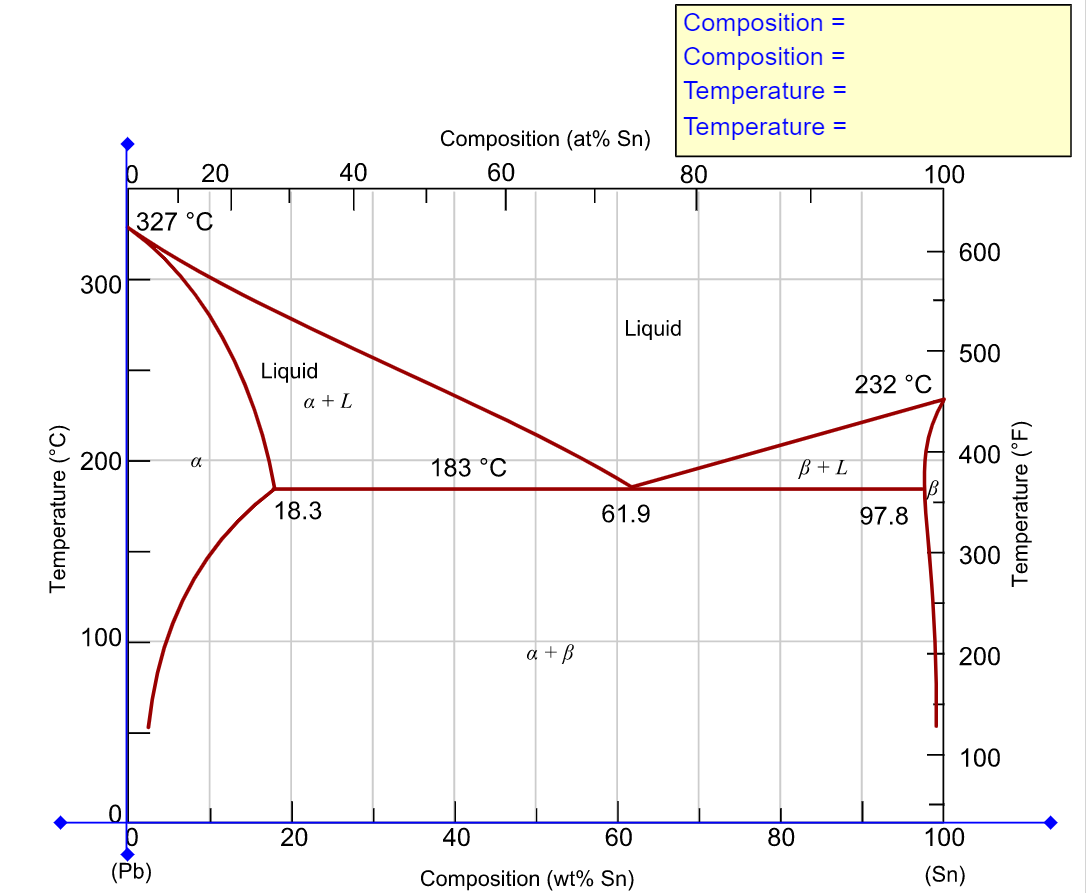A 1.5-kg specimen of a 88 wt% Pb-12 wt% Sn alloy (Animated Figure 9.8) is heated to 220°C; at this temperature it is entirely an a- phase solid solution. The alloy is to be melted to the extent that 50% of the specimen is liquid, the remainder being the a phase. This may be accomplished either by heating the alloy or changing its composition while holding the temperature constant.
A 1.5-kg specimen of a 88 wt% Pb-12 wt% Sn alloy (Animated Figure 9.8) is heated to 220°C; at this temperature it is entirely an a- phase solid solution. The alloy is to be melted to the extent that 50% of the specimen is liquid, the remainder being the a phase. This may be accomplished either by heating the alloy or changing its composition while holding the temperature constant.
Elements Of Electromagnetics
7th Edition
ISBN:9780190698614
Author:Sadiku, Matthew N. O.
Publisher:Sadiku, Matthew N. O.
ChapterMA: Math Assessment
Section: Chapter Questions
Problem 1.1MA
Related questions
Question

Transcribed Image Text:Composition =
Composition =
Temperature =
Temperature
Composition (at% Sn)
20
40
60
80
100
327 °C
600
300
Liquid
500
Liquid
232 °C
a + L
200
183 °C
ß+ L
400
18.3
61.9
97.8
300
100
a +B
200
100
20
40
60
80
100
(Pb)
Composition (wt% Sn)
(Sn)
Temperature (°C)
Temperature (°F)

Transcribed Image Text:A 1.5-kg specimen of a 88 wt% Pb-12 wt% Sn alloy (Animated Figure 9.8) is heated to 220°C; at this temperature it is entirely an a-
phase solid solution. The alloy is to be melted to the extent that 50% of the specimen is liquid, the remainder being the a phase. This
may be accomplished either by heating the alloy or changing its composition while holding the temperature constant.
(a) To what temperature must the specimen be heated?
i
°C
(b) How much tin must be added to the 1.5-kg specimen at 220°C to achieve this state?
i
kg
Expert Solution
This question has been solved!
Explore an expertly crafted, step-by-step solution for a thorough understanding of key concepts.
This is a popular solution!
Trending now
This is a popular solution!
Step by step
Solved in 2 steps

Knowledge Booster
Learn more about
Need a deep-dive on the concept behind this application? Look no further. Learn more about this topic, mechanical-engineering and related others by exploring similar questions and additional content below.Recommended textbooks for you

Elements Of Electromagnetics
Mechanical Engineering
ISBN:
9780190698614
Author:
Sadiku, Matthew N. O.
Publisher:
Oxford University Press

Mechanics of Materials (10th Edition)
Mechanical Engineering
ISBN:
9780134319650
Author:
Russell C. Hibbeler
Publisher:
PEARSON

Thermodynamics: An Engineering Approach
Mechanical Engineering
ISBN:
9781259822674
Author:
Yunus A. Cengel Dr., Michael A. Boles
Publisher:
McGraw-Hill Education

Elements Of Electromagnetics
Mechanical Engineering
ISBN:
9780190698614
Author:
Sadiku, Matthew N. O.
Publisher:
Oxford University Press

Mechanics of Materials (10th Edition)
Mechanical Engineering
ISBN:
9780134319650
Author:
Russell C. Hibbeler
Publisher:
PEARSON

Thermodynamics: An Engineering Approach
Mechanical Engineering
ISBN:
9781259822674
Author:
Yunus A. Cengel Dr., Michael A. Boles
Publisher:
McGraw-Hill Education

Control Systems Engineering
Mechanical Engineering
ISBN:
9781118170519
Author:
Norman S. Nise
Publisher:
WILEY

Mechanics of Materials (MindTap Course List)
Mechanical Engineering
ISBN:
9781337093347
Author:
Barry J. Goodno, James M. Gere
Publisher:
Cengage Learning

Engineering Mechanics: Statics
Mechanical Engineering
ISBN:
9781118807330
Author:
James L. Meriam, L. G. Kraige, J. N. Bolton
Publisher:
WILEY